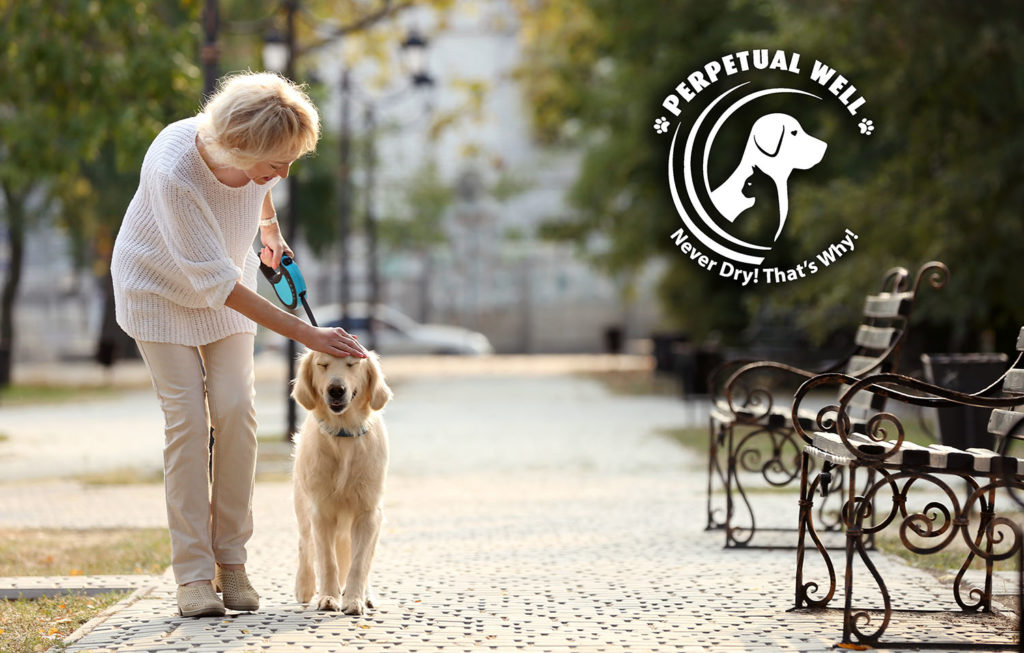Just because your senior dog isn’t the same walking companion he once was doesn’t mean it’s time to look for a new partner. In fact, taking a daily walk with your older pup can be one of the best things you do for him. Walking will keep his muscles strong and flexible, plus it’ll give him improved cardiovascular health, help maintain his weight, and decrease age-related anxiety. Even better, walking your senior dog offers quality bonding time with you. But before you begin or continue a walking regimen with your four-legged friend, learn how to make it the safest and most useful stroll it can be.
Stretch Your Pet Before and After Walking
Weakening joints and muscles will benefit from gentle stretching before and after movement. Be sure to give your senior dog an adequate warm-up and cool-down period as part of your walking session. Recommended stretches include hip flexions, bicycling the back legs, shoulder extensions, and sit and stand drills. Always check with a veterinarian for the best way to prepare your pet for exercise. A vet will be able to demonstrate safe and effective stretching techniques to use.
Set the Pace Mindfully
Although you’re in charge of the walk, be mindful of your older pet’s mobility level and choose a pace that’s comfortable for him but still provides adequate exercise. If you’re just starting a walking routine, begin slowly. Take short strolls around the block and build up to longer walks at a faster clip. Challenge your pet safely, with his health status and age in mind. Remember, any kind of movement will benefit your senior dog, so tailor the walk to his unique ability.
Offer Your Senior Dog Variety
Do you sometimes get bored with the same old exercise? Dogs do too, so try to switch things up on your walk to keep your senior pup interested and energetic. Alter your route or drive to a new, safe location, like a nearby neighborhood or park. You might try walking on a different surface. The American Kennel Club recommends grass and sand over asphalt and gravel for senior dogs. Avoid walking on overly soft sand, though, which can be hard on an arthritic pet’s joints.
Interact While Walking
Friendly conversation with your senior dog helps him feel safe and connected to you, but he can benefit from any interaction with you while out walking together. Keep your aging pet thinking, behaving, and enjoying your companionship by engaging in short obedience refreshers. Ask him to sit and wait at a crosswalk or practice eye contact, heeling, and on-leash recalls. Bring treats along and be sure to praise and reward your dog for being a good listener and walking partner.
Give Your Senior Pet All of You
If you have multiple dogs, leave the others at home. Younger dogs typically have more energy and speed than older dogs, making it more challenging for you to concentrate on your senior. Likewise, a chatty friend can divert your attention and even cause jealousy in your pet. Give your senior what he craves: all of you. He’ll appreciate one-on-one time with his favorite person, and that alone can make your walk more fulfilling and rewarding for both of you.
Watch for Hazards
Hazards while walking come in all forms, even when your pet is leashed by your side. If you see other dogs approaching, consider turning around or crossing the street. Your senior may not have the confidence and agility to handle encounters with unfamiliar animals. Inclement weather, uneven roadways, and traffic are other potential hazards to be aware of and plan accordingly for. Stay alert while you’re out walking together so you can keep your pet safe and content.
Make Walking Your Senior Dog a Regular Habit
Many senior dogs suffer stiffness and joint discomfort, an important reason to make exercising your aging pet a regular habit. Get on a daily walking schedule if possible. You won’t just improve his pain and joint function; you’ll also help manage his weight and reduce stress and anxiety, all which contribute to better health and longevity. Finally, regular walking provides structure, which has been shown to boost confidence, security, and good behavior in dogs.
Keep Track of Time
Don’t overdo walking with a senior dog. Older pets tire quickly and can be highly susceptible to overheating and dehydration. Make sure your dog is well hydrated before and after the walk with Perpetual Well automatic dog waterer. A half-hour or less is plenty of time for your senior dog to be out walking. If it’s a warm day, cut the walk short. Avoid getting too far away from home or your car, in case you need to turn around quickly and carry water with you for hydration. Finally, wear a watch so you can always keep track of time.
Treating your senior dog to a walk is something he’ll surely lap up, but make it a stroll he deserves. You’ll improve his fitness and give him a happier, healthier, and longer life with you.

